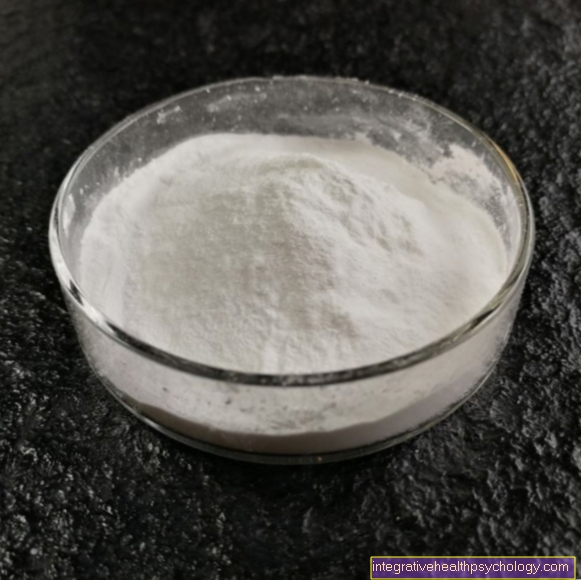Other diseases of the colon ...
Diverticulosis of the Colon
These are protuberances in the mucous membrane of the Large intestine preferably in the area of weak points at vascular openings. With low fiber food the low filling of the colon creates increased pressure in the intestinal lumen and diverticula can develop. This is supported by the fact that this disease occurs very rarely in population groups with a high fiber intake. Vegetarians are less likely to get sick than non-vegetarians. Diverticula do not regress with a high fiber diet. However, those with the Diverticulosis accompanying complaints (stomach pain, Stool irregularities) are reduced and diverticulitis (inflammation of the protrusions) can be counteracted. The gift of wheat bran has proven itself. As a source of fiber, this significantly increases the volume of the stool. It is essential to ensure that there is sufficient fluid intake!
Summary
A high-fiber diet is recommended as a preventive measure. At existing diverticula the administration of wheat bran can improve the symptoms. Provide sufficient liquid.
Irritable bowel syndrome
This malfunction of the Large intestine is characterized by intermittent cramp-like pain and often alternation between diarrhea and constipation without one Disease of the gastrointestinal tract (chronic inflammatory diseases, Colon cancer) is present. Relationships between diet and irritable bowel symptoms are also not clear. These patients only have certain intolerances (Coffee, raw fruit, fried food) which, however, can be very different individually. A diet high in fiber does not relieve the symptoms. Wheat bran can help if there is constipation.
Summary
Avoid foods that experience has shown to trigger or intensify the symptoms.
If the stool is constipated at the same time, the administration of wheat bran (adequate fluid intake!) Can help.
Cancer of the large intestine (colon cancer)
The development of colon cancer is largely influenced by environmental factors. Nutrition surveys carried out so far have for the most part revealed the following risks: the development of Colon cancer Can favor: The diet is rich in fat and animal protein and poor in complex Carbohydrates (Fiber, starch). A certain protective effect is attributed to the minerals calcium and selenium and the Vitamins A, C, D and beta carotene too
High-fat diet
Not only the amount but also the type of fat consumed seems to be important. Animal fats and polyunsaturated fats have a more negative effect, while monounsaturated fats (e.g. olive oil, rapeseed oil) and fish oils that are rich in omega-3 fatty acids have a positive and protective effect. The negative influence of a high-fat diet is explained by the increased release of bile acids after a high-fat meal. Most of the fat is in the Small intestine resumed and put back into circulation. A small part gets into the Large intestine, is broken down by the bacteria there and in animal experiments this increased the risk of developing colon cancer.
Protein-rich food
High meat consumption increases the risk for Colon cancer. Due to the high fat content of some types of meat, the relationship between fat intake and bile acids described above could also be used as an explanation.
High fiber diet
Dietary fiber increases the volume of the stool and the intestinal contents pass more quickly through the intestinal tract. As a result, any harmful substances contained in the food have less long contact with the intestinal mucosa. This effect can be the Carcinogenesis prevent. In addition, short-chain fatty acids are formed as an end product in the large intestine from fiber. One of them is the fatty acid n-butyrate. In laboratory tests, this fatty acid inhibits the growth of colon cancer cells.
Minerals and vitamins
For population groups that are calcium rich (mainly milk and milk products) colon cancer is less common. Selenium has shown a positive influence in animal experiments. However, this effect is of selenium not yet proven in humans and on the additional administration of selenium (toxic in high doses) should therefore be avoided. Studies have shown that vitamin C and beta-carotene have a protective effect and Vitamin D possibly together with Calcium has a positive influence. This hypothesis has yet to be confirmed. None of these connections between diet and the development of colon cancer are fully established. Nevertheless there is of the German Society for Nutrition Recommendations for reducing the risk of cancer.
Summary
Recommendations for Colon Cancer Prevention
Vegetables, whole grain products, fruits, potatoes and legumes should become the main component of the diet. Reduce fat and prefer positive fats (rapeseed oil, olive oil, fish oils with omega-3 fatty acids from cold water fish such as salmon, herring). Low-fat milk and dairy products daily Fish and poultry should be given preference over red meat. Of the Alcohol consumption should not exceed the amount of 20 g per day. An excessive Calorie intake should be avoided and daily exercise is recommended.
Anal fissures
Anal fissures have a poor healing tendency. To support the drug treatment, the administration of wheat bran with the appropriate fluid intake is recommended to relieve or prevent constipation. Constipation exacerbates the symptoms and delays the already poor healing tendency.
You can find out more about the topic here: Anal fissure
In the case of rectal ulcers, it is assumed that chronic injuries caused by hard stool play a major role in its development. Treatment with a high-fiber diet is therefore an obvious choice. According to an investigation by Brandt-Grädel et al., 15 of 20 patients with rectal ulcers healed after about 10 months of high-fiber diet. The daily diet of the patients contained 30 to 40 g of fiber consisting of 4 to 5 slices of wholemeal bread, 6 tablespoons of wheat bran and a high proportion of fruit and vegetables combined with the appropriate fluid intake.
Summary
For rectal ulcers and Anal fissures In addition to the drug treatment, a diet rich in fiber can have a positive influence on the healing process.





























